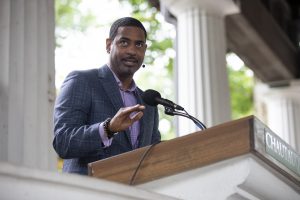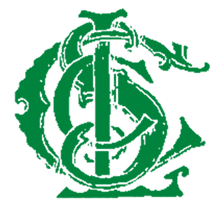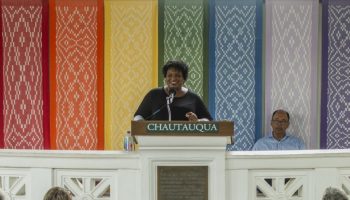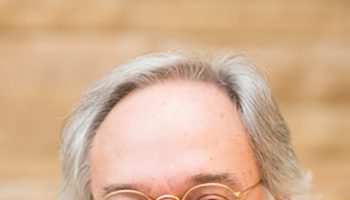
With great power comes great responsibility, and the only people who know that better than superheroes are the comic book artists responsible for creating them.
Comics have gone from the pages of the Sunday newspaper to movie screens, breaking records at the box office. They have shifted from humorous diversions to a source of cultural influence, a long, powerful journey rivaling only those of the characters within them.
At 2 p.m. Monday, July 23, in the Hall of Philosophy, the Rev. Otis Moss III, senior pastor of Trinity United Church of Christ in Chicago, gave his lecture, “Wakanda Forever: Comics, Subversion, and the Moral Imagination,” as part of Week Five theme, “The Ethics of Dissent.”
Comic books are a form of sequential art, a series of images arranged in a specific order to tell a story. This form of art originated with cave paintings in Egypt that were shared with the Greek and Roman empires, Moss said.
Constantine the Great, Roman emperor, recognized that his people were followers of Jesus and decided to convert to Christianity. He then became head of the church and implemented sequential art within cathedrals in the form of stained glass windows.
“It was a subversive, nonviolent, radical action that happens in Rome where sequential art became a part of the liturgy of worship,” Moss said.

Over time, sequential art evolved from stained glass windows, to graphics and then into comics that can be defined by five components: the moment frozen in time by the artist, the frame, the image in the frame, the words, and the flow, Moss said.
“When you are reading, you become a collaborator and a co-laborer with the artist,” he said. “You fill in the blanks with your imagination.”
According to Moss, the birth of modern-day comics came about in the “shadow of Nazism,” when weekly pamphlets were made about Superman, Batman and Captain America from 1938 to 1941.
In 1938, Jewish artists Jerry Siegel and Joe Shuster created Superman.
“(Siegel and Shuster) took their immigrant sensibilities and the subtext of being an outsider and placed them on paper to create Superman,” Moss said. “Superman is an immigrant story.”
Superman was an undocumented immigrant because he was sent away by his parents from the challenges and trials that were happening on his home planet. Once he arrived on earth, Superman was adopted by an American family and given the name Clark Kent. Moss said Siegel and Shuster did this to provide a subtext of their parents’ and grandparents’ experiences on Ellis Island.
In addition to immigration, there is also a Christ narrative in the comic.
“Superman was the only son of Krypton; his father sent him to Earth. He has powers that no one else does, and his job is to save everybody,” Moss said.
In 1940, the first “Batman” comic was released. Moss said Batman’s story is the most amusing because he has no real superpowers.
“Batman’s only power is privilege,” he said. “He is a millionaire; that’s really where his power comes from. The fact that I have all of that money gives me privilege to train myself, so I can fight against crime.”
Batman was also a representation of nonviolence, as he refused to kill because his parents were killed by gun violence.
In 1941, the first “Captain America” comic book was released. According to Moss, Captain America’s primary goal was to fight fascism and represent a “critique on masculinity.”
This superhero started as Steve Rogers, a normal man who was injected with a super-soldier serum and then became “powerful” and “a great soldier,” Moss said. However, Rogers began to criticize the military industrial complex and decided he did not want to fight for the military, but for the people.
“He eventually says, ‘It does not make me a man by my strength, it makes me a man by my ethics (and) what is in my heart,’ ” Moss said.
In 1942, Wonder Woman made her entrance. As an immigrant from the Amazon where there were no men, Wonder Woman became the first feminist character in a comic book.
“She brings to life this idea of ‘I will not define my humanity solely by a male hierarchy,’ ” Moss said.
Readers’ initial response to these characters was positive, but that changed in 1950 after Joseph McCarthy said comics were a danger to children’s minds.
“(McCarthy wondered), ‘What will happen to the minds of girls if they think they are a hero?’ ” Moss said. “What will happen to this world if kids think they are Superman or Batman or Captain America, and they begin to critique their generals and say, ‘What you ordered me to do is immoral?’ ”
Many comic book writers were frightened by McCarthyism, and started to rewrite the superheroes’ stories to make them more patriotic.
In 1955, comic books made a shift in a racial direction when Moss said a young man named Stan Lee witnessed Rosa Parks refuse to give up her seat on a segregated bus in Montgomery, Alabama.
“As he was witnessing it, he said, ‘Bigotry and racism are among the deadliest social ills plaguing the world today,’ ” Moss said. “But unlike a team of costumed villains, they can’t be stopped with a punch. The only way to stop them is to expose them.”
As a way to expose bigotry and racism in the United States, Lee created a series of characters known as the X-Men.
“He could not make his way down to Montgomery, he could not join the movement, so he said, ‘You know what? I am going to put the ideals of the movement in the comic book as a subversive idea that when any time a child reads it, they will understand what is happening out in the South,’ ” Moss said.
The X-Men story begins with the idea that there are certain people on earth who have the X-Gene, a mutant gene that gives each person a particular power. The main character in the book is Professor X, who is symbolic of Martin Luther King Jr. Professor X is a great visionary who believes he can teach the younger generation to not only be liberators, but also to participate in relieving suffering in the world, Moss said.
“He has a dream that those who have the X-Gene, who are different from the majority, can live in harmony with the majority even though they physically look different from it,” he said.
Another character in the comic is Magneto, symbolic of Malcolm X, who believed that people with the X-Gene had to build their own institutions because society would never accept them.
Moss said those differing opinions led the main characters to the overarching plot.
“The narrative was, ‘I look different and you treat me different,’ but here was the interesting thing: the American government wanted the labor of those with the X-Gene but did not want to give them citizenship,” Moss said.
The X-Men comics also contained symbols of immigration, most prominently symbolized in the “Mutant Registration Act.” Every mutant was required to register with the government to make sure they were not a danger to people around them. As a result of this, people began siding with and against the immigrants, and a civil war broke out.
“There is one group that says, ‘We need to document everybody and we need to make sure they do not come to our country,’ ” Moss said. “But there is another group that says, ‘Wait a minute, don’t you know that mutants make the country better?’ ”
According to Moss, the civil war in the comic series predicted the current “fight between red and blue states in America.”
“When art allows imagination to flow, and you are examining what is happening in the world, you can sometimes be prophetic in your communication,” he said.
Along with immigration, “X-Men” also contained a queer subtext because some mutants were forced to “live in the closet” to prevent registration or being placed in an internment camp.
Whether they are superheroes or X-Men, Moss said all comic book characters share the same “moral center.”
“All of them do not want to kill, and all have a vision of what the world and the nation can be,” he said.
The most recent example of a comic character with a moral center comes from “Black Panther.”
“Black Panther” is set in Wakanda, a technologically superior African country in the Marvel Universe. Wakanda is ruled by the Black Panther, also known as King T’Challa.
According to Moss, T’Challa’s power comes from the “ancient and holy spirit of the panther.”
“Anyone can be endowed in this spirit, and it is not your strength but your integrity that gives you your real power,” Moss said. “If you have a moral center, then anyone can be a hero.”
However, it is not just big name superheroes who symbolize greater issues. One example of a less well-known comic is “Jessica Jones.” Jones is a detective whose character symbolizes the #MeToo movement through her experience with sexual assault.
“She was attempting to do (an) investigation when someone assaulted her, someone of great power who had power by using their voice to force people to do what they do not want to do,” Moss said. “It is a painful story, but also critiques what is happening in the world today.”
In modern times, graphic novels like Black Panther and Maus are used in schools all over the world to teach about subjects like racism, the Holocaust, faith, life and death.
One that stands out to Moss is a graphic novel he gave to his daughter titled I Kill Giants. The story begins with a young girl who isn’t paying attention in school. When her teachers ask what she’s doing, she says she’s busy killing giants. Later on in the comic, it is revealed her mother was dying of cancer and that was the giant she was trying to fight.
“It is a powerful book that helps you understand grief, and that everybody will have to face the giant,” Moss said.
Ultimately, Moss believes the only way comic books can be be used to their full potential is if children and adults alike indulge in the messages they represent.
“Maybe if we had a narrative like Clark Kent, we wouldn’t be seeking so many walls,” Moss said. “Maybe if we had a narrative like Luke Cage, we would understand that everyone has worth. Maybe if we had a narrative like Wonder Woman, we would not have to deal with so many hashtags. Because if they are imagining a world that is not yet, there is a moral center.”





